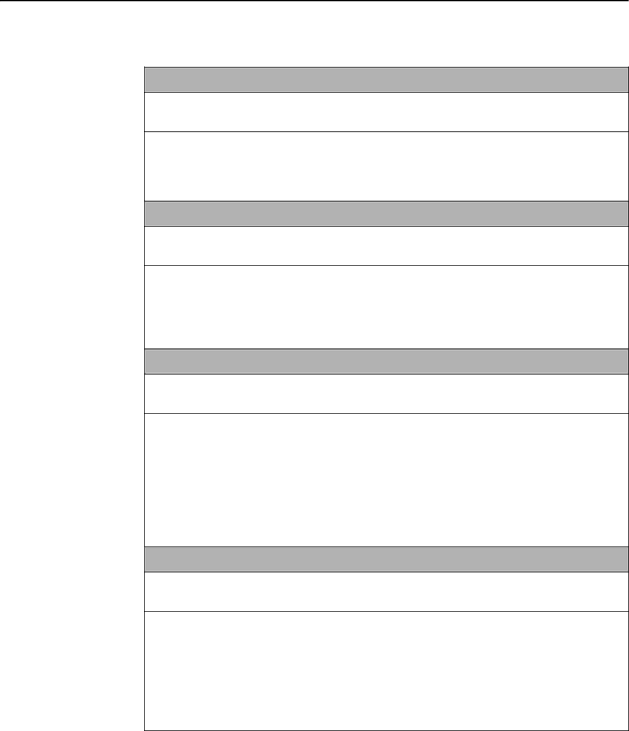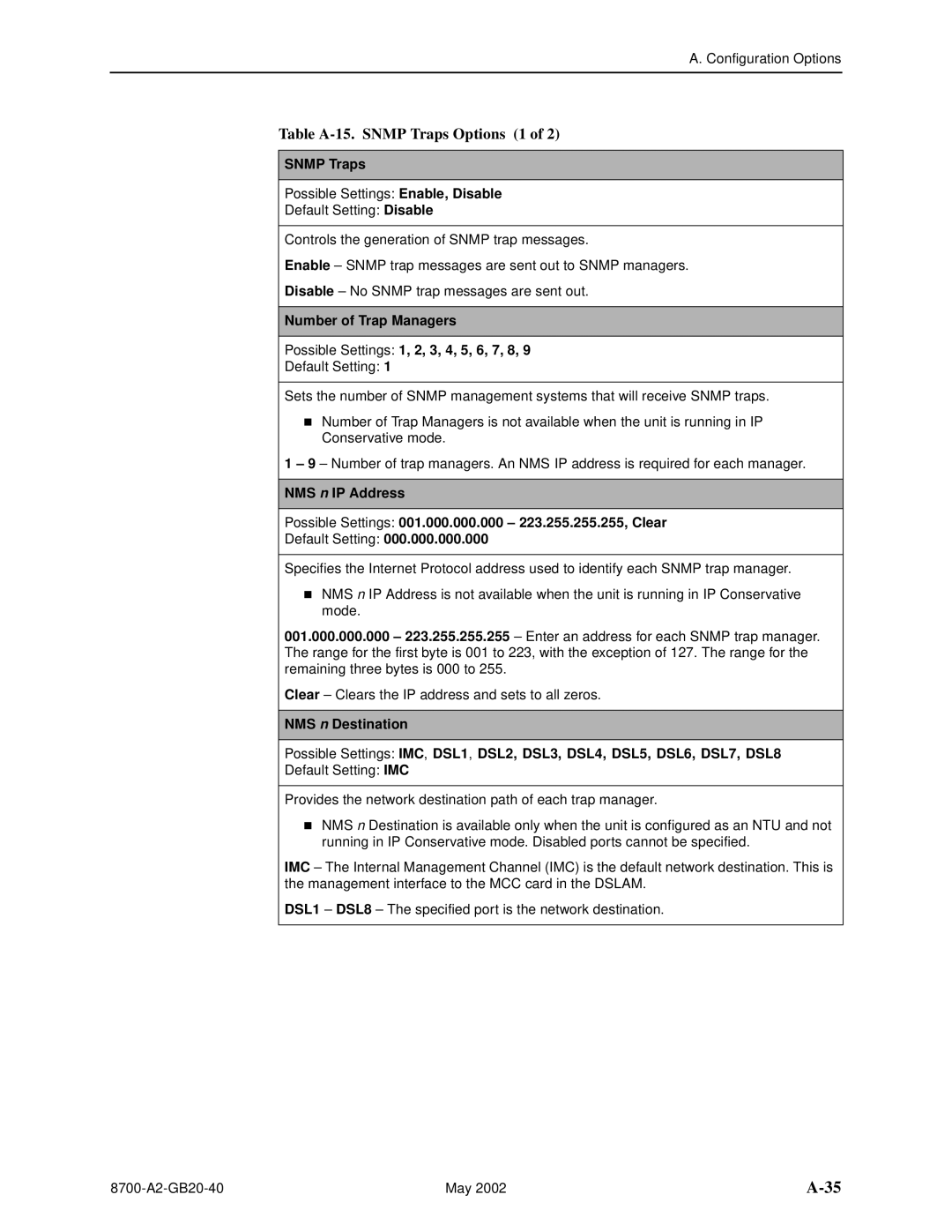Hotwire TDM Sdsl Termination Units
Copyright 2002 Paradyne Corporation All rights reserved
Contents
Security
Cross-Connecting Ports
Monitoring and Troubleshooting
IP Addressing
Configuration Options
Testing
Transferring Firmware and Configurations Using Tftp
Index
Connector Pin Assignments
Technical Specifications Cross-Connection Worksheets
Standards Compliance for Snmp Traps
Document Summary
New Features for this Release
About This Guide
Document Purpose and Intended Audience
Document Number Document Title
Product-Related Documents
TDM Sdsl Overview
About Hotwire 8777 TDM Sdsl Units
Model Has eight Eight
TDM Sdsl Features
CO Site
Network Configuration
Customer Premises CP
Snmp Trap Support
Snmp Management Capabilities
Management Information Base MIB Support
Documents in About This Guide
Using the Asynchronous Terminal Interface
User Interface Access
Management Serial Port Settings
Initiating an ATI Session
Logging In to the Hotwire Dslam
Login
Main Menu
Select
Inband
Menu Hierarchy
Keys
Main Menu → Configuration → Current Configuration→ Network
Screen Work Areas
Function
Press
Navigating the Screens
Keyboard Keys
For the screen Function Select Press Enter to
Function Keys
Example
Switching Between Screen Work Areas
Exiting From the Dslam Session
Ending an ATI Session
Using the Asynchronous Terminal Interface May
Overview
Initial Startup and Configuration
Identity
Entering Identity Information
Main Menu → Control→ Change Identity
Configuration Option Area Configuration Option Set
Configuring the Unit
Configuration Options
If you select Then
Accessing and Displaying Configuration Options
Main Menu → Configuration Load Configuration From
Load Configuration from
Configuration EDIT/DISPLAY
Current and Default Factory Configurations
Table A-5
Select Access To Configure
DSL
Configuration Loader
Main Menu → Configuration → Configuration Loader
Configuration Loader
Completed successfully
Save Configuration
Saving Configuration Options
Resetting the Device
Restoring Access to the User Interface
Disabling AutoRate
Resetting AutoRate
Main Menu → Configuration → Current Configuration → Network
Main Menu → Control → Reset AutoRate
Download Code
Downloading Firmware
Main Menu → Control → Download Code
Apply Download
Initial Startup and Configuration May
Cross-Connecting Ports
Determining the Configuration
DSL
Mode
Setting the Cross-Connect Modes
Slots of DSL Ports 1
Assigning Time Slots
Data or v Voice = DSL = DSX-1
Assign Time Slots
Following example shows the configuration for DSX-1 Port
CROSS-CONNECT Mode
Cross-Connecting Ports May
Selecting an IP Addressing Scheme
Configurations Not Running IP Conservative Software
Configuration Options
IP Addressing
IP Addressing Example
All Configurations
Appendix A, Configuration Options
Security
ATI Access Levels
Login Entry
Creating a Login
Administer Logins
On the Login Entry Screen, for Enter
Deleting a Login
Configuration Options, to
Controlling Snmp Access
Assigning Snmp Community Names and Access Types
Management Options, in Appendix A, Configuration Options
Security May
What to Monitor
Monitoring and Troubleshooting
System and Test Status Health and Status SELF-TEST Results
Viewing System and Test Status
Main Menu → Status→ System and Test Status
Yyyyyyyy
Health and Status Messages
Monitoring and Troubleshooting
See Network Interface Options
See G.703 Interface Options
DTE
Self-Test Results Messages
Monitoring and Troubleshooting
Test Status Messages Meaning
Test Status Messages
Device Messages 1 What Message Indicates What To Do
Device Messages
Device Messages 2 What Message Indicates What To Do
Performance Statistics
Network Error Statistics
Viewing Network Error Statistics
Field Contains
Viewing Network Performance Statistics
Field Contains
Performance Statistics
Viewing DSX-1 Performance Statistics
Field Contains
Viewing G.703 Performance Statistics
Interval is displayed. When zero, the port is disabled
Febe
Viewing Current Network Performance Statistics
SES
Inband Management Statistics
Viewing Inband Management Statistics
Dlci
System
Viewing LED Status
System
Display LEDs Screen Type Label Value is Indicating
LED is Indicating
Front Panel LEDs
Changing the Meaning of the Ports LEDs
Troubleshooting
Troubleshooting 1 Symptom Possible Cause Solutions
Testing
Troubleshooting 2 Symptom Possible Cause Solutions
Test
Testing
Accessing the Test Menu
Main Menu → Test
Network & G.703 Tests
Running Network Tests
Network & DSX-1 Tests
8700-A2-GB20-40 May
Network Line Loopback
Repeater Loopback
DTE Loopback
Remote Send Line Loopback
Send and Monitor
Device Tests
Device Tests
Lamp Test
Main Menu → Test→ Device Tests
Ending an Active Test
Activation Line Payload Remote Line Deactivation Loopback
Telco-Initiated Tests
Telco-Initiated Line Loopback
Telco-Initiated Payload Loopback
Telco-Initiated Remote Line Loopback
DSL1
Transferring Firmware and Configurations Using Tftp
Transferring Firmware and Configurations Using Tftp
Procedure
Configuration Loader
Completed successfully
Transferring Firmware and Configurations Using Tftp May
Select To Access To Configure
Configuration Options
Margin Threshold
Network Interface Options Menu
Table A-1. Network Interface Options 1
Port Status
AutoRate
Excessive Error Rate Threshold
Table A-1. Network Interface Options 2
Peer IP Address
Possible Settings 001.000.000.000 223.255.255.255, Clear
Table A-1. Network Interface Options 3
Transmit Attenuation
Circuit Identifier
Table A-1. Network Interface Options 4
DS0 Cross Connect Line Framing
Configuration Options
Line Coding Format
Main Menu → Configuration → Current Configuration → DSX-1
DSX-1 Interface Options Model
Table A-4. DSX-1 Interface Options Model 8777 1
Primary Clock Source
Table A-4. DSX-1 Interface Options Model 8777 2
Line Framing
Interface Options
Main Menu → Configuration → Current Configuration → G.703
Interface Options Model
Table A-5. G.703 Interface Options Model 8779 1
Line Coding
Table A-5. G.703 Interface Options Model 8779 2
Framing
Table A-5. G.703 Interface Options Model 8779 3
To Port y
Copy Ports Options
Table A-6. Copy Port Options
From Port n
Table A-7. System Options 1
DSL Mode
Test Timeout
System Options
Remote Telco Line Loopback
Table A-7. System Options 2
Test Duration min
Telco Initiated Loopback
System Clock
System Clock
Figure A-1. System Timing
Figure A-2. System Clock Configuration Examples
Table A-8. System Clock Options
Cross-Connect
CROSS-CONNECT Configuration
Following screen is displayed for Model
Setting Cross-Connect Mode
Mode DSL
DSL Port
Table A-9. Cross-Connect Mode Options Model
Source
Table A-10. Cross-Connect Mode Options Model
Following screen is displayed for a DSX-1 port Model
Assigning Time Slots
Assign Time Slots DSL
Time Slot Number
Port
Table A-11. Assign Time Slots Options 1
DSX-1/DSL or G.703/DSL
Port Type
Data or Voice
Table A-11. Assign Time Slots Options 2
Start TS
Assign To
Telnet Session Options
Management and Communication Options Menu
Telnet Session Options
Table A-12. Telnet Session Options
General Snmp Management Options
General Snmp Management Options
Table A-13. General Snmp Management Options 1
Snmp Management
Community Name
Name 1 Access
Name 2 Access
Table A-13. General Snmp Management Options 2
NMS
Snmp NMS Security Options
Snmp NMS Security Options
NMS IP Validation
Access Type
Table A-14. Snmp NMS Security Options
Snmp Traps Options
Snmp Traps Options
Snmp Traps
Table A-15. Snmp Traps Options 1
Link Traps Interfaces
Link Traps Possible Settings Disable, Up, Down, Both
Table A-15. Snmp Traps Options 2
Enterprise Specific Traps
PPP
Inband Management Channel Model
Inband Management Channel
Table A-16. Inband Management Channel Options Model
Configuring and Testing Inband Management
Cross Connect Mode
Cross Connect Mode screen appears
= Ibmc
Following screen appears
Configuration Options
IfIndex Description
Standards Compliance for Snmp Traps
Snmp Traps
IfIndex
Snmp Trap Description Possible Cause
AuthenticationFailure
WarmStart
LinkUp and linkDown
LinkUp/DownTvariable bindings
Enterprise-Specific Traps
IfType RFC 8700-A2-GB20-40 May
May
Front Panel 50-pin DTE Connector Pinouts
Connector Pin Assignments
Connector Pin Assignments
Port Tip, Ring
Table C-2. Rear Connector Pinouts Connector Pins
Connector Pin Assignments May
Technical Specifications
Technical Specifications May
Cross-Connection Worksheets
Using the Worksheets
Port Connection Diagram
TS01
DSX-1 Time Slot Assignments
Time Slot Assignments DSX-1 Port
Time Slot Assignments DSX-1 Port
Time Slot Assignments DSX-1 Port
Time Slot Assignments DSX-1 Port
Time Slot Assignments DSL Port
Time Slot Assignments DSL Port
Time Slot Assignments DSL Port
Time Slot Assignments DSL Port
Time Slot Assignments G.703 Port
Time Slot Assignments
Time Slot Assignments G.703 Port
Time Slot Assignments G.703 Port
Time Slot Assignments G.703 Port
Time Slot Assignments G.703 Port
Time Slot Assignments G.703 Port
Time Slot Assignments G.703 Port
Time Slot Assignments G.703 Port
Time Slot Assignments DSL Port
Time Slot Assignments DSL Port
Time Slot Assignments DSL Port
Time Slot Assignments DSL Port
Time Slot Assignments DSL Port
Time Slot Assignments DSL Port
Time Slot Assignments DSL Port
Time Slot Assignments DSL Port
Snmp
Index
IN-2
IN-3
IN-4
IN-5
IN-6

